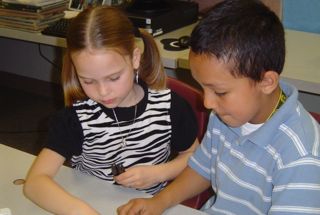Joan Moser
October 5, 2012
"Where do we begin?" This heartfelt lament was recently issued to us from some truly wonderful Kindergarten teachers. Having had many years of experience as a Kindergarten teacher, I understand that feeling of "Where do I begin? They need so much!" This overwhelmed feeling isn't limited to my experience with five-year olds, though. It creeps in any time the students in front of Gail and I seem insurmountably far from the standards set before them. So, where do we begin?
 Voracious Reading, from the traditional CAFE menu, is a constant for us and we mention it on a daily basis because voluminous reading is a key to reading growth for students of all ages. When talking about Voracious Reading, we also frontload our students by casually introducing other strategies into the focus lesson to begin building background knowledge. Then, when students are ready for the direct instruction, they are already a bit familiar with the phrases and vocabulary. For example - "Boys and girls, listen to how I read this part. This is what a fluent reader sounds like (read a portion smoothly, with expression). Now listen to what it sounds like if I am not reading fluently (read word by word, in a monotone voice). When we read voraciously, it helps us become fluent readers. When we can read fluently, we will understand and enjoy reading more!"
Voracious Reading, from the traditional CAFE menu, is a constant for us and we mention it on a daily basis because voluminous reading is a key to reading growth for students of all ages. When talking about Voracious Reading, we also frontload our students by casually introducing other strategies into the focus lesson to begin building background knowledge. Then, when students are ready for the direct instruction, they are already a bit familiar with the phrases and vocabulary. For example - "Boys and girls, listen to how I read this part. This is what a fluent reader sounds like (read a portion smoothly, with expression). Now listen to what it sounds like if I am not reading fluently (read word by word, in a monotone voice). When we read voraciously, it helps us become fluent readers. When we can read fluently, we will understand and enjoy reading more!"
We model other strategies from each area of The CAFE Menu to build background knowledge, with the understanding that not everyone will emulate them immediately. Early lessons typically focus on the following:
- Comprehension - Check for Understanding
- Comprehension - Backup and Reread
- Comprehension - Use prior knowledge to connect with text
- Comprehension - Make and adjust predictions; use text to confirm
- Accuracy - Use the pictures. Do the words and pictures match?
- Accuracy - Cross Checking...Do the pictures and/or words look right? Do they sound right? Do they make sense?
- Vocabulary - Tune in to interesting words and use new vocabulary in speaking and writing. A love of and enthusiasm for words is always on display in our rooms. Both our students and ourselves use a "Word Collector" to save our personal favorites. Check out this word collector for the bulletin board and how we use it.
Have you ever played with a balance scale? Do you remember adding small weight after small weight to one side, watching in anticipation for the tray on the other side to budge? It was exciting when an added weight finally brought movement and the trays balanced.
We think instruction is a little bit like that. It's as though each student is sitting on one side of a balance scale. All their experiences and background knowledge, though lighter, are weighing in on the other side of the scale. Every bit of instruction we deliver adds another weight to their scales. Some students, because they were at the tipping point already, are going to move right away as a result of the timely lesson. For others, it is simply a necessary building block, which will accrue with others until that student too is ready for movement.
For those of you working with pre-readers, ELL, or struggling students, you are going to spend a lot of time making those important deposits by adding 'weights' to their scale in the form of excellent instruction. Don't be disheartened. Each story shared, lesson taught, strategy modeled, is accumulating in those impressionable hearts and minds. If you continue to make the deposits, you will eventually reap the joyous rewards.





